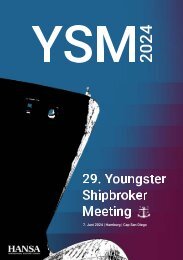HANSA 10-2017
Fährschifffahrt | Brexit | HIPER | Schifffahrt der Zukunft | Börsenbericht | US Ports & Hurricanes | Abwasser | Häfen Niedersachsen | HVAC | Job-Börse | Offshore-Marktkompass
Fährschifffahrt | Brexit | HIPER | Schifffahrt der Zukunft | Börsenbericht | US Ports & Hurricanes | Abwasser | Häfen Niedersachsen | HVAC | Job-Börse | Offshore-Marktkompass
Sie wollen auch ein ePaper? Erhöhen Sie die Reichweite Ihrer Titel.
YUMPU macht aus Druck-PDFs automatisch weboptimierte ePaper, die Google liebt.
Schifffahrt | Shipping<br />
The major ports on the U.S. East<br />
Coast serve local markets along with<br />
the vast hinterlands that lie to the east of<br />
the »equal transportation cost line« described<br />
by transport expert Robert West<br />
(see sidebar) from the Columbia based<br />
consultancy Duaga. Along the East<br />
Coast of Canada, the local markets are<br />
smaller, and rail connections from the<br />
Maritime Provinces to the mid Continental<br />
hinterlands are more attenuated.<br />
However, a tantalizing opportunity may<br />
exist to trans-ship cargo to ports along<br />
the U.S. East Coast. Three ports could<br />
potentially be hubs, Sydney N.S., Halifax,<br />
N.S. and, possibly, St John N.B. for<br />
shipments down the coast.<br />
Albert Barbusci, Principal at Harbor<br />
Port Development Partners (HPDP) –<br />
the consortium behind »Novaporte«,<br />
the potential deepwater mega terminal<br />
at Sydney, explained to <strong>HANSA</strong> that a<br />
new terminal at Sydney (with proximity<br />
to Europe on the Great Circle navigation<br />
route) could benefit from economies<br />
scale, with 80% of cargo trans-shipped<br />
to the U.S. East Coast and the balance<br />
sent by rail to Canadian markets including<br />
Montreal. The consortium behind<br />
HPDP, which would be privately funded,<br />
is impressive. It includes Canadian pension<br />
funds, the construction giant AE-<br />
COM and the Asian behemoth Chinese<br />
Communication Construction Company<br />
(the parent of container crane maker<br />
ZPMC). Additionally, if the project<br />
moves ahead, the HPDP team will consist<br />
of port operator Ports America, and<br />
the global design/ engineer firm Stantec.<br />
A tale of two hubs<br />
The Port of Halifax, where the<br />
<strong>10</strong>,000 TEU »Zim Antwerp« called at<br />
the Halterm facility owned by a Macquarie<br />
Infrastructure Partners fund, is<br />
examining its potential as larger vessels<br />
become the norm. Late last year, the port<br />
began a strategic planning exercise, led<br />
by engineering stalwart Parsons Brinckerhoff,<br />
to prepare for the advent of larger<br />
vessels. A representative of the port<br />
told <strong>HANSA</strong>: »Infrastructure planning<br />
is well underway as we look at ways in<br />
which we can expand or develop the<br />
necessary pier length required to berth<br />
and service two vessels over <strong>10</strong>,000 TEU<br />
simultaneously. In partnership with key<br />
stakeholders, we are exploring various<br />
options to fully understand what is possible<br />
and how it can be developed in an<br />
effcient, cost effective manner.« The representative<br />
noted that: »We are looking<br />
for a solution that will serve the economy<br />
of the region well into the future.«<br />
Where plans are on the drawing<br />
boards, as we can see in Eastern Canada,<br />
the catalyst for investors/ backers to pull<br />
the trigger is a commitment from a major<br />
carrier to call at a facility, an »anchor<br />
tenant«, in the parlance of property developers.<br />
So far, nobody has taken a bite<br />
at this apple. Mr. West from Duaga summarized<br />
the possible role for trans-shipping<br />
along the East Coast of Canada, saying:<br />
»From a high altitude perspective,<br />
the Canadian transshipment is a ‘parallel<br />
concept’ to the Caribbean transshipment<br />
triangle for Asian cargo shipped through<br />
Panama. One can imagine the Canadian<br />
ports serving North Atlantic US ports,<br />
shipped through Suez, and the Caribbean<br />
ports serving the South Atlantic ports<br />
and Mexico Gulf.«<br />
Novaporte to rise with Cosco?<br />
What needs to occur for trans-shipment<br />
to happen? With recent alignments of<br />
companies two amalgamations are<br />
worth watching. The first is the combination<br />
of Cosco and China Shipping<br />
Container Lines (CSCL), now called Cosco<br />
Shipping Lines. The merger dynamics<br />
caused the alliance profile to shift,<br />
the new company joined the Ocean Alliance<br />
(where CSCL had been a member),<br />
and quickly closed a deal which<br />
sees it gobbling up the parent of fellow<br />
alliance member Orient Overseas Container<br />
Lines (OOCL). Another Asian<br />
tie-up is the Ocean Network Express,<br />
or »ONE«, composed of three Japanese<br />
liner giants NYK, K Line and MOL.<br />
Novaporte’s star may rise with Cosco’s<br />
might. Though it currently operates<br />
its Asia/USEC services through Panama,<br />
if Cosco were to be lured towards Suez<br />
(where its alliance partner CMA CGM<br />
already routes its vessels), the Canadian<br />
trans-ship option could take on real viability.<br />
In Halifax, multiple moving parts<br />
would need to fall into place. Ceres Terminals<br />
is wholly owned by ONE member<br />
NYK. The Japanese carriers are already<br />
transiting via Suez for 2 of 5 strings in<br />
their Asia/USEC services, would need to<br />
shift more capacity to Suez. If rumoured<br />
plans to move the Ceres Terminal (presently<br />
restricted by bridge heights), or<br />
Halterm, across the harbor to less congested-Dartmouth,<br />
actually coalesce,<br />
then deep drafted megaships could more<br />
readily call Halifax.<br />
M<br />
Panama, Suez and<br />
North Americas Ports<br />
»Neo-Panamax« vessels, with capacities<br />
of up to 13,000 TEU began calling at<br />
ports along the U.S. East Coast and<br />
Canada. Recently, the newbuild<br />
14,400 TEU »CMA CGM T. Roosevelt«,<br />
after claiming the title of most capacious<br />
container vessel to transit the Canal,<br />
called the coast at Savannah, Charleston,<br />
Norfolk, and then New York – where<br />
the newly raised Bayonne Bridge allows<br />
an airdraft of 215ft, with cargo<br />
inbound from Asia. Further north, the<br />
<strong>10</strong>,000 TEU »Zim Antwerp« called at<br />
Halifax in late June (following a call at<br />
the Port of New York).<br />
These accolades come at a time of<br />
swelling trade volumes; mid <strong>2017</strong> TEU<br />
throughputs for East Coast ports suggest<br />
double digit overall TEU growth<br />
(> <strong>10</strong>%), compared to 2016. Imports,<br />
the mainstay of box moves, have benefitted<br />
based on the strong US$, and the<br />
steady, albeit modest, economic<br />
growth in the States. The East Coast<br />
has picked up additional cargo. Robert<br />
West from Duaga, explained to HAN-<br />
SA that: »Most of the shift to the Panama<br />
Canal (from USWC) happened<br />
before the new locks were open. Of<br />
course, there was a slight surge after<br />
the opening, once the shipping lines<br />
realized that it was going to happen in<br />
fact.« He added that: »The ‘equal transportation<br />
cost line’ at which the cost is<br />
the same from either coast has shifted<br />
more to the west, thereby giving the<br />
USEC ports a bigger market to serve<br />
inland.«<br />
Attention-grabbing laurels for »biggest«<br />
and »most TEUs« along the<br />
USEC should not distract market<br />
participants from the broader influences<br />
swirling around the dynamic<br />
market. The Suez Canal (reconfigured<br />
in 2015 to handle larger vessels) hopes<br />
to lure Asia/ US East Coast traffc away<br />
from Panama. After having cut its rates<br />
on oil tanker transits, it is set to<br />
lower tolls in container vessels, starting<br />
in October, <strong>2017</strong>. Panama, in the<br />
meantime, is set to adjust its tolls in<br />
order to attract more backhaul (Atlantic<br />
to Pacific) business for large »Neo-<br />
Panamax« vessels. Meanwhile, on the<br />
vessel side, new constellations resulting<br />
from mergers or cooperation agreements<br />
among carriers have created<br />
the impetus for shifting trade routes.<br />
<strong>HANSA</strong> International Maritime Journal – 154. Jahrgang – <strong>2017</strong> – Nr. <strong>10</strong> 25


















